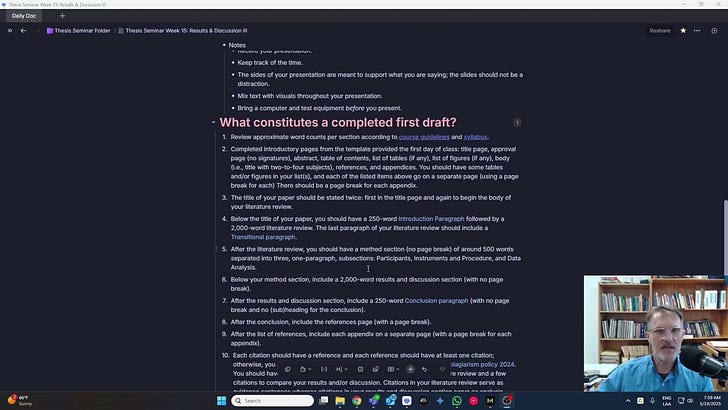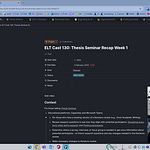Executive Summary:
This document summarizes key instructions and guidelines provided for the completion of the first draft of the thesis paper and preparation for the mock presentations. The sources emphasize adherence to formatting requirements (APA 7th edition), content guidelines for specific sections (Abstract, Introduction, Literature Review, Method, Results/Discussion, Conclusion, Appendices, References), and preparation strategies for the mock presentations, including content, delivery, and technical aspects. Key themes include attention to detail in formatting, summarizing the paper effectively, and practicing delivery and anticipating questions for the presentation.
Key Themes and Ideas:
Hard Copy Draft Review: Students are required to submit a hard copy of their first completed draft. A quick self-review in groups is encouraged, focusing on specific formatting elements.
Headings: Check that all headings (except in the method section) have 6 to 12 words. Main words should be capitalized. No punctuation should be at the end of any heading. Method section headings (Participants, Instruments, Procedure, Data Analysis) can be shorter.
Page Breaks: Specific pages should be on their own page: Title page, Authorization page, Abstract, Table of Contents, Figures/Tables (if applicable), and each Appendix. The body of the paper (Literature Review through the Conclusion paragraph) should have no page breaks.
Spacing: The entire paper should be double-spaced, with no extra space between paragraphs, headings, and text. References are an exception, with single spacing within the reference and double spacing between references.
Indentation: Each paragraph, except for the Abstract, should have a half-inch indentation.
Paragraph Count: The Abstract, Participants, Instruments, Procedure, and Data Analysis sections should each consist of only one paragraph. The final paragraph of the paper is considered the Conclusion paragraph and does not require a separate "Conclusion" heading.
Appendix Formatting: Each appendix should start on a new page with a Level 1 heading (e.g., "Appendix A") at the very top line, followed by a Level 2 heading for the appendix title.
Title Recommendations: The instructor suggests using ChatGPT to generate title ideas now that the paper is mostly complete.
If the title is longer than one line, force a return to distribute words more or less equally across two lines.
Single-space the title.
Improving Writing (Verb Usage): Students are encouraged to review their paper for overuse of the verbs "to have," "to be," and "to make" (as lexical verbs). While not forbidden, excessive use may indicate areas for improvement by substituting more dynamic verbs, often converting nouns into verbs. The instructor provides an example of how to rewrite sentences to be more concise and dynamic.
Mock Presentation Structure and Timing: The mock presentation is 20 minutes long with a 10-minute Q&A. The entire class scheduled for a specific day is expected to observe all presentations on that day.
Suggested Slide Order: Title slide, Problem and Purpose, Literature Review (multiple slides), Method, Results and Discussion (multiple slides), Conclusions, Thank You.
Approximate Timing: Problem and Purpose (30 seconds to 1 minute), Literature Review (approximately 8 minutes), Method (approximately 2 minutes), Results and Discussion (approximately 9-10 minutes).
Presentation Content: Present only the essential information that directly relates to the research questions and analyzed data. Do not attempt to present everything from the written paper due to time constraints.
Mock Presentation Delivery and Technical Aspects:
Preparation: Practice the presentation, ideally recording oneself and timing each section. Consider practicing in front of someone.
Slides: Slides are meant to support the speaker, not to be read directly. They should function as "big note cards" with key points or ideas. Each slide should focus on one main point and include a heading. Avoid paragraphs and excessive text on slides.
Visuals: Make slides visually appealing but not distracting. Use visuals like graphs, charts, tables, and images from the paper, simplifying or modifying them for the presentation. Use no more than three different font styles and sizes, and choose easy-to-read fonts. Avoid animations and complex color schemes that might reduce contrast.
Technology: Coordinate with classmates to use one computer for presentations on a given day. Test equipment beforehand, turn off automatic updates, and ensure the computer is fully charged and doesn't go to sleep. Have a backup of the presentation file (e.g., on a USB drive in addition to the computer).
Delivery: Focus on the message, not personal nervousness. Maintain eye contact with the audience, specifically the examiners during the final defense, distributing attention among them. Bring a water bottle.
Anticipate Questions: Prepare for potential questions, including definitions of key terms used in the study.
Final Oral Defense Considerations:
Similar guidelines to the mock presentation, but attendance is by invitation only (family, friends, classmates).
Coordinate bringing refreshments for the examiners.
Arrive at least 30 minutes early with guests.
Maintain eye contact, especially with examiners.
No microphone is expected to be needed; speak loudly and project.
Present from the stage or on the floor in front of the stage, based on comfort.
Paper Submission: Submit three hard copies of the first completed draft. Confirm that the version in Microsoft Teams is the same as the hard copy. The final paper (Word document and three hard copies) is due officially one week before the scheduled presentation.
Quotes:
"Make sure that the headings all of the headings have 6 to 12 words except for the headings in the method section."
"Check each heading to make sure that the main words are capitalized."
"Finally, check at the end of each heading. No punctuation, no period, no colon, no. Nothing."
"The body of the paper, there are no page brakes."
"Make sure each appendix has a page break and appears at the very top line."
"Make sure that each paragraph with the exception of the abstract has a half of an inch indentation."
"Look at the abstracts. Each section of the method and your conclusion to make sure you only have one paragraph."
"Today, I'm going to receive your uh hard copies of your first completed draft. This is an important milestone, right?"
"Today I want to spend just a few minutes very quickly all of us taking a look at your document, making a few notes very very quick."
"I would recommend trying and experimenting with chatt to give you some ideas of titles now that your paper has been completed."
"If your title extends longer than one line... force a return... single space the title."
"I want you to see how many times you're using three birds. to have, to be, to make."
"The problem in general is when we're using a bunch of times these verbs voice passive and there is there are. The problem is we have a lot of nouns that could be converted to a verb."
"We need to be prepared on Monday, well, whenever you're presenting, for a 20 minute presentation with a 10 minute question and answer."
"Remember your presentation is there to support what you are saying, not vice versa."
"Think of the the PowerPoint presentation the slides as big cards note cards."
"We don't want any distractions, right? It's a distraction when you're speaking and somebody's coming in and out."
"Maintain eye contact... try to connect to those examiners because they're the ones that are going to give you the grades."
Source 2: Excerpts from "TS Recap 15.mp4"
This source provides a recap of Week 15 for Thesis Seminar, focusing on the requirements for the first completed draft of the thesis paper due the same week.
Key Themes and Ideas:
First Completed Draft Requirements: The first completed draft is due as a hard copy. Students should refer to the course guidelines for detailed requirements, including approximate word counts.
Introduction Paragraph: Should start with a hook, provide context for the problem, and end with the thesis statement.
Transitional Paragraph: Should restate the thesis statement, summarize the problem, introduce the research questions, and conclude with a closing statement.
Conclusion Paragraph (End of Results and Discussion): Approximately 250 words. Should begin by restating and rewording the thesis statement, discuss study limitations and significance, suggest future research, and end with a closing statement.
Abstract: Should be on its own page, follow the provided template, and be one paragraph of approximately 250 words. It should summarize the entire paper: problem, method (participants, data collection, analysis), findings, and conclusions/implications. It serves as a snapshot for readers to decide if they want to read the full paper.
Formatting (Reinforced):Title: 6 to 12 words.
Spacing: Double-spaced throughout the paper (except references).
Alignment: Left-justified.
Indentation: 0.5-inch indentation for all paragraphs except the Abstract.
References: Adhere to APA 7th edition. Use a hanging indent (French indentation). Single-space within each reference and double-space between references.
Appendices: Each appendix on a new page with a Level 1 heading ("Appendix A," etc.) and a Level 2 heading for the title. Use the specified font styles (Level 1 APA, Level 2 APA, etc.) for headings.
Table of Contents: Should be updatable based on correctly formatted headings.
Approximate Word Counts: Provides word count guidelines for major sections: Literature Review (approx. 2250 words), Results and Discussion (approx. 2250 words), Method (approx. 500 words, divided among Participants, Instruments and Procedure, Data Analysis).
Quotes:
"This week, we need to finish our first draft. And today, I want to talk about what should be included in your completed first draft. Uh a hard copy that you're to turn in by noon this Thursday, May 22nd, 2025."
"Make sure that you've uh reviewed the course guidelines that are available in Microsoft Teams... it includes a section with approximate word counts."
"Your paper should include an introductory or an introduction paragraph... make sure that the uh the introduction paragraph begins with a hook. It offers the context of the problem and it concludes by stating your thesis statement."
"The conclusion paragraph to end your results and discussion section should be approximately 250 words and begin again with your thesis statement restated and rewarded."
"After restating your thesis statement, you can talk about um any limitations that you find... include the significance of your study and also future research."
"The abstract should be on its own page... Should be one paragraph, approximately 250 words, and should state basically summarize uh your whole paper."
"Think of the abstract as a kind of a snapshot of your whole paper."
"Make sure you have a title of your paper, 6 to 12 words."
"Your whole paper should be double spaced, left justified."
"All paragraphs should have a uh 0.5 in indentation with the exception of the abstract."
"Double check your list of references making sure that they adhere to APA 7th edition."
"Make sure you using a French indentation or a uh a hanging indent."
"Each appendix should have a level one heading that states which appendix it is... And then as a level two, I would include the title of the of the appendix."
Conclusion:
Both sources provide essential guidance for completing the thesis paper draft and preparing for the mock presentations. The first source delves deeply into specific formatting checks and detailed presentation strategies, while the second source provides a concise overview of the key components and formatting requirements for the written draft. Students are strongly encouraged to meticulously review their drafts against the provided guidelines, practice their presentations thoroughly, and anticipate questions to ensure a successful mock presentation and final defense. Attention to detail in both the written document and the presentation delivery is paramount.












Share this post